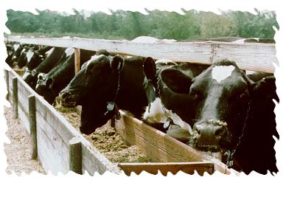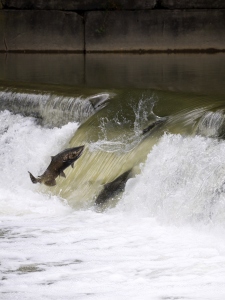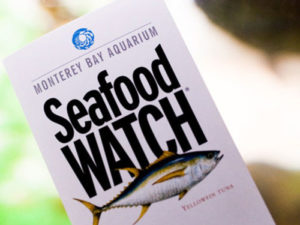
Here are a few other issues to consider when shifting to locally raised and sustainably produced meat, poultry and seafood.
- Cattle feeding operations pose another significant environmental threat. About 1.4 billion metric tons of solid manure are produced by U.S. farm animals each year – 130 times the quantity produced by people. That amounts to 100,000 metric tons of manure per minute. This figure includes pigs and chickens as well as cattle, but cattle are the single largest source. The manure creates methane, a potent global warming gas. It also leaks into the groundwater, causing major pollution problems.
- In addition, two-thirds of the beef cattle raised in the U.S. are fattened up using hormones like steroids, testosterone and progesterone. When these are excreted, they have the potential to pollute drinking water. The European Union bans beef from the U.S. because it contains growth hormones.
- Chickens, turkeys, and pigs create similar environmental problems when they are raised in industrial feedlots.
- Some “farm-raised” seafood, especially salmon and shrimp, can also endanger the environment. Producing one pound of farm-raised salmon or shrimp, for example, requires two to three pounds of wild fish for feed. The waste from fish farms can pollute coastal waters . And if farmed fish escape into the wild, they can threaten the survival of native fish.
- Some varieties of fish, like tuna and swordfish, are dangerous especially for pregnant women and children, due to the high level of toxins they contain.
- Fish and shellfish in the wild are being caught to excess and some, to the point of extinction. The cod fishery in the North Atlantic has already collapsed due to overfishing.
About Fish

The problem is that many fish are contaminated from heavy metals like mercury and lead, industrial chemicals like PCBs, and pesticides like DDT and dieldrin. These contaminants enter the water in several ways: from factory discharges, runoff from farms and lawns, and air pollution that falls into lakes, rivers, streams and the sea from sources like power plant cooling towers and automobile exhaust tail pipes. Fish can absorb these toxins in their skin, organs and fatty tissue.
Over time, the more toxin-laden fish you eat, the more contaminants can build up in your body. Health problems may include various birth defects and even cancer. According to Environmental Defense, it can take 5 years or more for women in their childbearing years to rid their bodies of PCBs, and 12-18 months to significantly reduce our body burden of mercury. Mothers who eat contaminated fish before becoming pregnant may have children who are slower to develop and learn. Developing fetuses are exposed to stored toxins through the placenta. Women beyond their childbearing years and men face fewer health risks from contaminants than children do.
You’ve probably heard the most about mercury in canned tuna. Both the Environmental Protection Agency and Environmental Defense recommend that adults and children limit consumption of canned white tuna, which consists of albacore, a large species that accumulates moderate amounts of mercury.
Canned light tuna usually consists of skipjack, a smaller species with approximately one-third the mercury levels of albacore. Therefore, Environmental Defense only recommends that young children (ages 0-6) limit their consumption of canned light tuna. However, recent news reports suggest that some canned light tuna actually contains yellowfin tuna, a species that is similar in size and mercury content to albacore. These products are sometimes (but not always) labeled ‘gourmet’ or ‘tonno’, and their consumption should be limited by adults and children. Overall, it’s best to exercise caution in how much tuna you (or especially your children) consume.
Fish that are caught or farmed in an ecologically sound manner and thus are low in contaminants include wild salmon from Alaska (fresh, frozen and canned), Atlantic mackerel and herring, sardines, sablefish, anchovies, farmed oysters and tilapia.
You can learn more about your Best and Worst Seafood Choices from Environmental Defense’s Oceans Alive website.

You can also check in with the Marine Stewardship Council, a non-profit organization set up to protect fish from over-fishing. Your dollars can make a difference by buying seafood that’s carefully harvested so that fish like cod and rockfish, whose populations have been severely depleted, stay alive. Look for seafood sold under the Marine Stewardship Council label.
For Your Shopping List:
- Substitute wild Alaskan salmon for farmed salmon. (Atlantic salmon in U.S. stores and restaurants is always farmed.)
- If you live in New England and want to serve cod, opt for hook-caught instead of trawl-caught Atlantic cod. If you live on the West Coast, sablefish/black cod is a good replacement.
- Farmed striped bass can be used as a substitute for many species of depleted fish such as Pacific rockfish, grouper, snapper, orange roughy and Patagonian toothfish (often called Chilean seabass).
- Farmed tilapia is another tasty alternative.
- Mary Lu Seafoods – this West Coast albacore tuna is sustainably harvested and canned in its own juice; it claims to contain less mercury than other tuna brands.
- EcoFish – Organic shrimp, mahi mahi, wild Alaska salmon, and more, canned and fresh frozen.
If you want some help when you shop, Environmental Defense has prepared this handy Pocket Seafood Selector you can print out and keep in your wallet.
If you don’t want to eat fish but you want the benefit of fish oil supplements, you still need to worry about the same contaminants showing up in the oil. Capsules should be made from purified fish oil. Here’s more about fish oil supplements and the results of an Environmental Defense survey on the safest supplements to buy.
To find locally-produced meat and poultry, plug your zipcode in to this map managed by Local Harvest and the Food Routes Network. You’ll find nearby farmer’s markets, direct-sell farmers, and whole foods markets where you can buy beef, chicken and pork that’s hormone and antibiotic free.
- Coleman Natural Meats and Laura’s Lean Beef are two companies that sell hormone-free beef in grocery stores.









